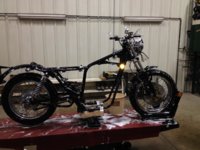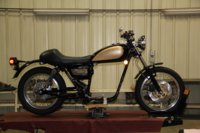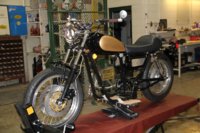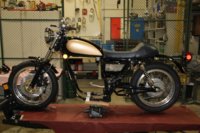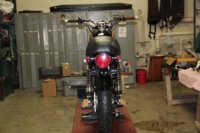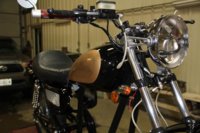XStretchified650
Back in the 650 Saddle
Hi Forum Members,
I am looking for suggestions and advice on maintenance or smart upgrades I should do with the engine of my XS650D. I am in the 'home stretch' of a thorough restoration that I started about three years ago. Yea, three years is a long time but I only get to work on it for a month or two during the winters. I've done a lot of custom work on the rest of the bike and I don't want to screw up my new motorcycle by neglecting the motor.
A little engine history:
It has 18,700 miles on it now and I've owned it since it had 1500.
When I parked it 24 years ago it ran just fine.
I would regularly adjust the valves and cam chain tension. About every 1000 miles.
It did not noticably consume oil.
I always used Castrol 20/50 (back then it was considered the good stuff). I will be reading past threads on recommended oil.
It has always been inside a building and out of the weather.
It is bone stock and on a stand on the bench.
I have a new sump filter and cam chain tensioner to install. And a gasket set on hand.
The motor had a really small oil leak at the base gasket. Small... but it was always there.
The clutch is all original.
It has stock points type ignition.
The carburator set is 100% refreshed and ready to go back on.
Please speak up and help me bring this sleeping beast back to life.
I'll post pictures of the rest of the build in a few days. Thanks in advance for your suggestions and advice.
John (Xstretchified650)
I am looking for suggestions and advice on maintenance or smart upgrades I should do with the engine of my XS650D. I am in the 'home stretch' of a thorough restoration that I started about three years ago. Yea, three years is a long time but I only get to work on it for a month or two during the winters. I've done a lot of custom work on the rest of the bike and I don't want to screw up my new motorcycle by neglecting the motor.
A little engine history:
It has 18,700 miles on it now and I've owned it since it had 1500.
When I parked it 24 years ago it ran just fine.
I would regularly adjust the valves and cam chain tension. About every 1000 miles.
It did not noticably consume oil.
I always used Castrol 20/50 (back then it was considered the good stuff). I will be reading past threads on recommended oil.
It has always been inside a building and out of the weather.
It is bone stock and on a stand on the bench.
I have a new sump filter and cam chain tensioner to install. And a gasket set on hand.
The motor had a really small oil leak at the base gasket. Small... but it was always there.
The clutch is all original.
It has stock points type ignition.
The carburator set is 100% refreshed and ready to go back on.
Please speak up and help me bring this sleeping beast back to life.
I'll post pictures of the rest of the build in a few days. Thanks in advance for your suggestions and advice.
John (Xstretchified650)

 If you have the gaskets pull as many parts as you think you should. Replace that base gasket and inspect from the pistons on up. There may also be gummed up oil or hard carbon in the rings.
If you have the gaskets pull as many parts as you think you should. Replace that base gasket and inspect from the pistons on up. There may also be gummed up oil or hard carbon in the rings.
